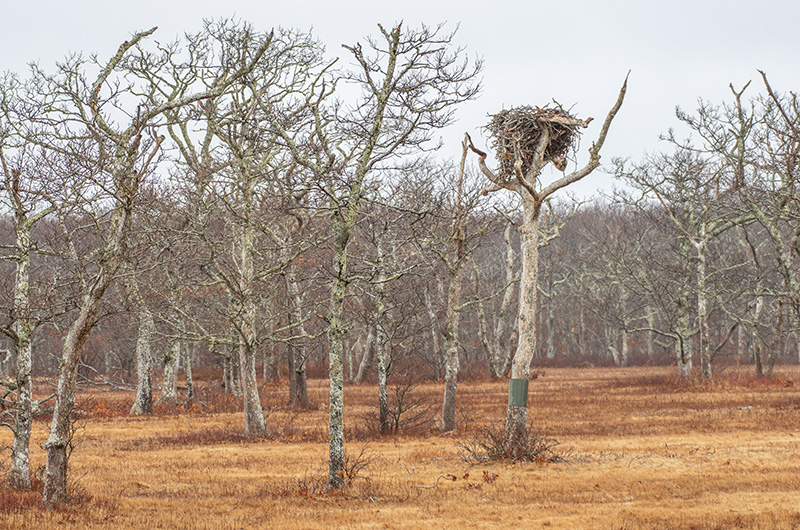Spring has arrived early this year on the sandy outwash plains along the south shore of Martha’s Vineyard, their unique ecology originally shaped by glaciers thousands of years ago. Bits of green are beginning to show beneath tawny native grasses. Salt-blasted oaks are still a month or more away from budding out, but all around new life is beginning to stir. Osprey and other migratory birds have begun their annual return to mate and build nests.
One such nest, built from a collection of mishapen sticks high in a bare-branched dead oak, has been the focus of much anticipation in recent weeks.
Once an osprey nest, it had been taken over by two bald eagles beginning last year. Island naturalist Gus Ben David noticed the eagles doing what is referred to as housekeeping, where the birds carried sticks to the nest.
For years, bald eagles have been visiting Martha’s Vineyard, the majority of them immature, but they have never nested here.
This spring, the two eagles returned and laid eggs, a first in the natural history record books for the Vineyard.
Mr. Ben David began carefully monitoring the birds. The nest is on private property, with the exact location not being disclosed out of concern for protecting the birds.
According to last year’s state-wide eagle count, Mr. Ben David said there are 70 pairs of nesting bald eagles in Massachusetts. And while the species is still considered threatened, bald eagles have made a tremendous comeback from the brink of extinction in the 1950s and 1960s. At the time, the pesticide DDT had a calamitous effect on egg production in many species of birds. Suddenly eggs were laid with soft shells, or no shells at all, that were crushed by the weight of the brooding parent.
In 1972, the federal government banned the use of DDT in the United States. In 1982, the Massachusetts Division of Fisheries and Wildlife and Mass Audubon joined forces to restore bald eagles as a breeding bird in the commonwealth. Mr. Ben David was involved in the project, which began with two eagle nestlings brought in from Michigan and raised in a nest platform on the Prescott peninsula in the Quabbin Reservoir near Amherst.
Mr. Ben David estimates that the nesting bald eagles on the Vineyard are about five years old. Over the past week he had been out to check on the nest a few times, and on Wednesday

he encountered a new turn of events. An osprey, quite likely the same osprey that had nested there previously, was unhappy about the new tenants and took action.
“It’s spectacular,” Mr. Ben David said, observing the forces of nature at work. “What the osprey do is come in and do these incredible dives. They come down and almost hit the mother eagle. The female eagle jumps up and flips over so that her talons are up trying to grab the osprey. Then, when she comes back down, she breaks the eggs.”
Which is exactly what happened.
Now that the bald eagles have broken their eggs, they will likely desert the nest and the ospreys will take over, Mr. Ben David said. Territorial aggression is commonplace in many species of large birds, he also said.
“They might hold their ground for a little while but eventually the ospreys are going to win out. It’s nature’s way, it’s perfectly natural and it happens.”
But the pair might return in the future to try again.
“What may happen is this pair of bald eagles may stay on the Vineyard right through the season or they may wander off to the northern states,” Mr. Ben David said. “But then, probably next year, they will come back again. Now whether they’ll try to nest in the same nest we don’t know.”








Comments (11)
Comments
Comment policy »